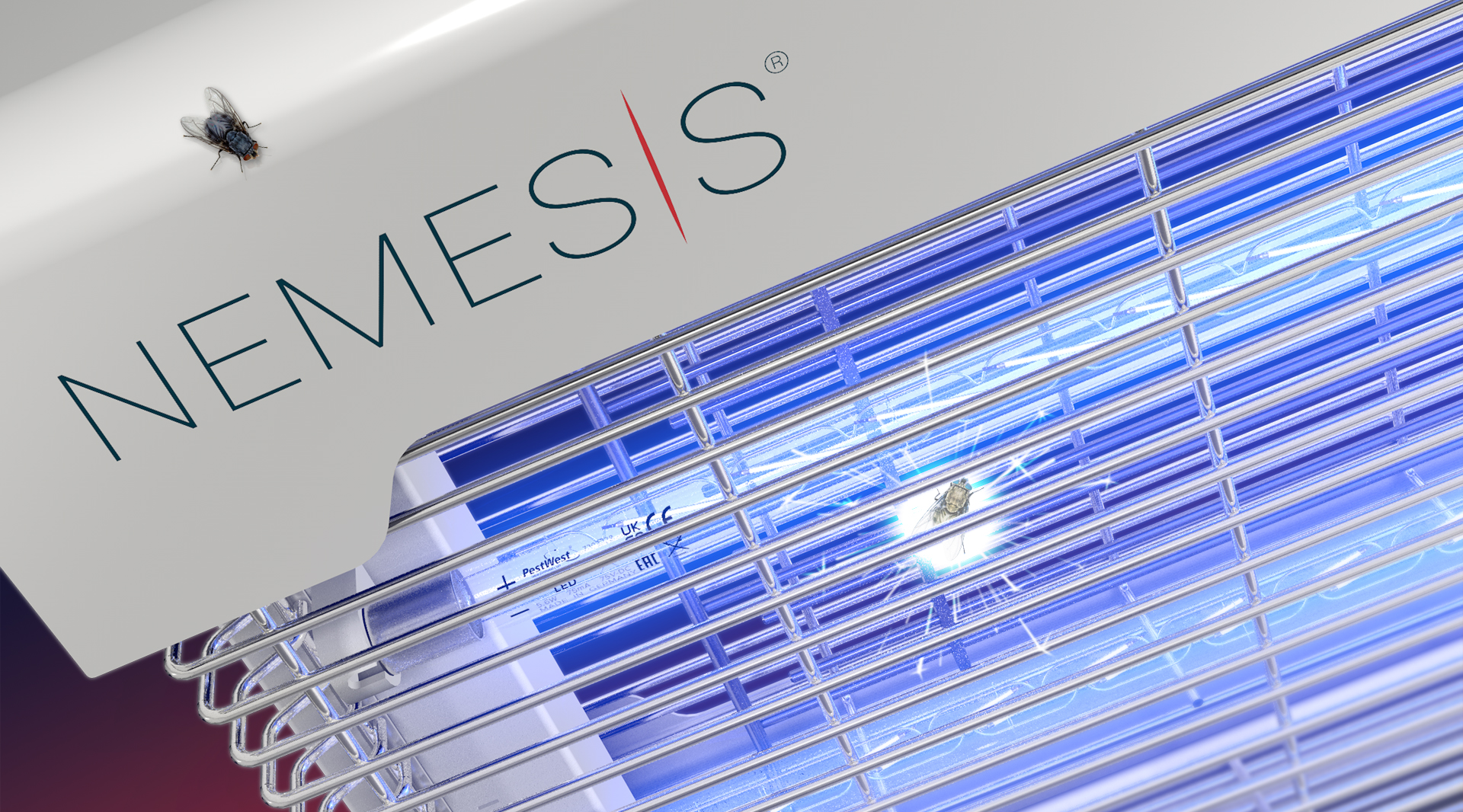The Science of Nemesis® X: The Electrifying End of a House Fly
By Dr. Stuart Mitchell
Picture this: a House fly (HF), Musca domestica, the ever-bothersome antagonist of human spaces, lands on the electrified grid of the Nemesis® X, an innovative flying insect management system. With an instantaneous and decisive electrocution event, HF’s fate is sealed. But what exactly happens in those milliseconds? Let’s explore the physiological and neurological events unfolding during this interaction, while highlighting the cutting-edge technology behind the Nemesis® X.
First contact-electrical conduction through the body…
When HF interacts with the Nemesis® X grid, the high voltage creates a pathway for electrical current to flow through its body. The voltage differential overwhelms the resistance of HF’s cuticle and internal tissues. In some events, a small electrical arc forms at the contact point if the voltage exceeds the dielectric breakdown of air (~3000 V/mm).
First contact marks the start of a chain reaction that neutralizes HF in milliseconds. The Nemesis® X design ensures uniform electrical grid coverage to maximize the efficacy of the electrocution process.
System shutdown-neurological disruption…
The electrical current hyper-excites HF’s neurons, triggering a massive and uncontrolled release of neurotransmitters. This overstimulation leads to instantaneous seizures and tetanic contraction, as HF’s muscles contract simultaneously. The high voltage disrupts ionic gradients across neural membranes, effectively shutting down neural activity.
This phenomenon, called neuro-depolarization, leaves HF completely paralyzed. Within milliseconds, the nervous system collapses, ensuring no recovery. The Nemesis® X performs this disruption with surgical precision, highlighting its engineering excellence.
Heat generation and tissue damage…
- As electrical current flows, heat is generated within HF’s body mass due to internal resistance.
- Heat causes significant tissue damage.
- Cuticle scorching, burning, or charring of the exoskeleton near the contact points.
- Internal liquefaction or denaturation of proteins and vaporization of cellular fluids, leading to the rupture of internal organs.
- Electrical discharges or arcs exacerbate heat effects, creating small explosions as fluids within HF vaporize.
Nemesis® X mitigates the risks of flying insect debris with its removable catch tray. This ensures that hygiene is maintained even in high-use scenarios.
Cardiac and respiratory collapse…
HF’s dorsal vessel (analogous to a heart) is incapacitated by the electrical current, halting hemolymph (insect “blood”) flow. Simultaneously, spiracles and tracheal tubes, which facilitate gas exchange, are physically damaged. This respiratory failure ensures that oxygen delivery to cells ceases, further contributing to HF’s rapid demise.
Irreversible damage-immediate death…
The combined effects of neural shutdown, muscle paralysis, and thermal destruction lead to immediate cellular death. Damage is so extensive that recovery is improbable, even if contact with the grid is brief. The Nemesis® X ensures that its high-voltage, yet low-amperage, delivers rapid and efficient fly control.
Observational outcomes…
The aftermath of the electrocution event is sometimes visible. HF is dislodged by the force of the current, falling into the catch tray as a charred carcass. End-users might observe debris on the grid. The Nemesis® X catch tray simplifies HF capture, while enabling end-users to analyze flying insects for trends and root cause analyses.
Harnessing Quantum® X LED technology…
At the heart of the Nemesis® X are two novel Quantum® X LED filament lamps, each designed to optimally attract flying insects with a 360° beam emission of 370 nm UVA light. This advanced lamp technology uses 432 LED filaments, hermetically sealed in a glass tube with state-of-the-art gas cooling, ensuring superior UVA light quality and fly-capture performance.
With FEP shatter-resistant coating, Quantum® X LED lamps are Pb and Hg free, aligning with sustainability goals. The PestWest Mad Hatter® Lamp Recycling Program underscores commitment to environmentally responsible pest management.
Maximum efficacy-strategic placement…
Proper placement is essential for optimal Nemesis® X performance. Place the system with minimal ambient light competition and suspend at least 8.2 ft (2.5 m) above grade, assuring height and 360° line of sight. Flexible wall and ceiling mounting options make Nemesis® X adaptable to various non-food-processing environments.
A bonus feature-Cluster Fly (CF), Pollenia rudis, control…
With a simple modification, Nemesis® X manages large Cluster fly flushes by removing the catch tray and using an appropriate separate container. Add the PestWest exclusive Cluster Fly Lure to further enhance this feature, making the system a versatile solution for multiple pest scenarios.
Science in action…
From its high-voltage grid to its state-of-the-art Quantum® X LED technology, the Nemesis® X showcases the power of innovation and precision engineering. Every aspect of its design, from the safety interlocks to the eco-friendly LED lamps, prioritizes safety, efficiency, efficacy, and sustainability.
For the fly…it’s an electrifying end. For you…it’s the assurance of a more hygienic space and control of the ever-bothersome antagonist of human spaces…courtesy of Nemesis® X.





